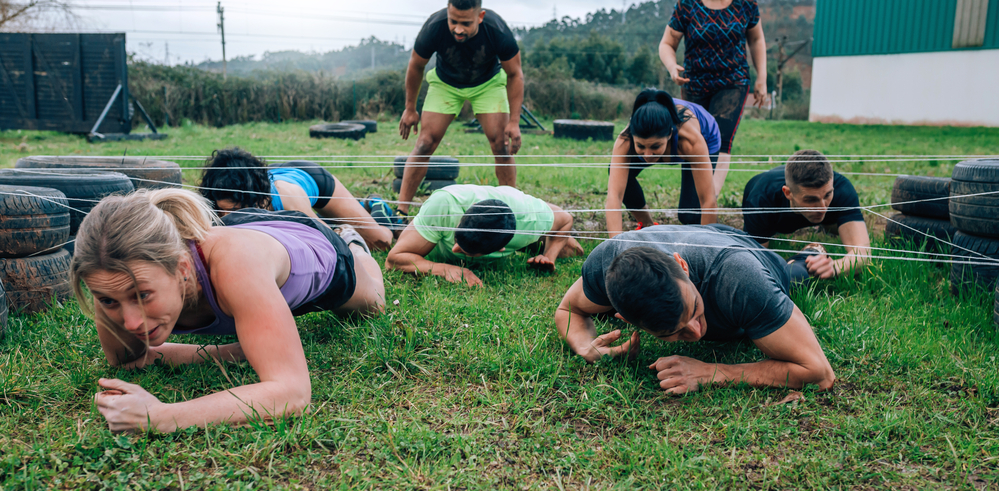A healthier life
Preparing for a Spartan Race requires a robust and specific training regimen tailored to its unique demands. This ultimate guide on training for Spartan Race will equip you with practical strategies to boost your strength, endurance, and obstacle-navigating skills. Expect to dive into focused workouts designed for conquering Spartan obstacles, long-distance running techniques to enhance your stamina, and high-intensity interval training that sharpens your race-ready edge. Whether you’re a first-timer or a seasoned Spartan, the actionable insights shared here will prepare you for the rigors of the course ahead.
Key Takeaways
- Develop a diverse workout regimen incorporating strength training, climbing skills, plyometrics, and grip strength exercises tailored for the obstacles you’ll encounter in a Spartan Race.
- Build up your endurance with long-distance running, incorporate HIIT workouts, and prioritize active recovery to ensure peak performance during the race.
- Prepare strategically for race week with proper tapering, nutrition, and hydration, and equip yourself with the right gear and apparel to tackle the Spartan Race with confidence.
Conquering Spartan Race Obstacles: A Training Primer

Time to unleash the Spartan within you! Spartan Race, a test of endurance, speed, and strength, is no walk in the park. You’ll need to conquer various obstacles, each demanding a unique set of skills. But don’t worry, we’ve got you covered with some essential Spartan training tips to help you dominate.
The key to overwhelming the Spartan Race obstacles lies in integrating exercises such as:
- push-ups
- pull-ups
- squats
- lunges
- plyometrics
Mastering climbing walls and monkey bars will be your secret weapon on race day. Cross training will be your ally, incorporating strength and conditioning, endurance, athleticism, and speed, agility, and quickness (SAQ) – all vital for the diverse challenges presented in a Spartan Race.
Mastering Grip Strength
A firm handshake can make a good impression, but a strong grip can help you conquer a Spartan Race. Grip strength is essential for dominating Spartan Races as it targets the muscles needed for a strong grip and stability, boosting your performance in climbing, navigating obstacles, and lifting heavy weights.
Don’t underestimate the power of a good grip. Incorporate exercises like inverted rows, and use a thick pull-up bar and a wide kettlebell handle. Push yourself with hanging drills and intense training to exceed the race’s demands. With improved grip strength, you’ll find yourself conquering obstacles more effectively and avoiding penalties.
Powering Through Climbs
Ready to scale new heights? Becoming proficient in climbing techniques forms an integral part of the Spartan Race training. You can:
- ‘walk’ up the wall
- use your arms and legs to pull yourself on top
- climb the wall like a ladder, keeping your body as close to it as possible
- use heel or leg hooks
All of these techniques can be effective in climbing the wall.
Augment your climbing prowess by adding jump squats, kettlebell swings, push press, thrusters, broad jumps, single-leg broad jumps, power drills, and A-skips to your workout routine. And don’t forget to elevate your grip strength game by diving into targeted grip and core training, mastering dead hangs on a pull-up bar, and embracing bouldering to amp up your pinch and crimp grips.
Rope Climb Techniques
Climbing a rope can be a daunting obstacle. But once you master rope climbing techniques like the S and J hooks, you’ll find yourself ascending with ease. These techniques distribute the workload between your upper and lower body, making your climb more efficient and preserving your upper body strength.
Safety should always be a priority during rope climbs. Equip yourself with grippy gloves for a secure hold, train with a spotter and a pad, and master the S-wrap technique to maintain your grip and avoid sliding. With these techniques, you’ll scale that rope and conquer the obstacle course in no time.
Building Endurance: The Runner’s Edge
As you venture into the Spartan Race, endurance will be your ally. The ability to persist through grueling obstacles and challenging courses requires a level of physical stamina that’s built over time. Wondering how to build this endurance? The solution lies in long-distance running coupled with active recovery techniques.
Aim for at least 6 miles for your weekly long run, and gradually increase your mileage. Incorporate high-intensity interval training (HIIT) workouts and perform tempo runs. Optimize your diet for endurance, and ensure you actively prioritize recovery. And lastly, engage in active recovery to clear out blood lactate and muscle waste, leading to faster recovery and a significant boost in endurance.
Long-Distance Running Tips
Taking on long-distance running requires more than just lacing up your shoes and hitting the pavement. It’s about maintaining an upright posture with a slight forward lean, ensuring your strides land under your center of gravity, and relaxing your shoulders. By selecting the right gear and following a well-tailored training plan, you can elevate your long-distance running and build up your stamina.
The secret to successful long-distance running lies in the ability to maintain a consistent pace. By incorporating regular practice runs at your goal pace into your weekly routine and refraining from starting too fast or attempting to speed up towards the end of the run, you’ll be well on your way to dominating your pace during your long-distance runs.
Active Recovery Strategies
No training plan is complete without factoring in recovery. Active recovery involves incorporating low-to-moderate intensity activities like:
- walking
- swimming
- yoga
- foam rolling
These activities enhance recovery and facilitate muscle repair.
For a stellar Spartan Race performance, think about including active recovery workouts like:
- Bear Crawls
- Stretching
- Forest walks
- Low-intensity cycling
- Light jogging
- Swimming
- Yoga
- Dog-friendly hikes
- Foam rolling
Embrace these techniques and elevate your endurance game.
High-Intensity Interval Training (HIIT) for Spartans
Now let’s turn up the intensity! High-Intensity Interval Training (HIIT) is a dynamic training protocol that seamlessly combines intense bursts of anaerobic exercise with short recovery intervals. It’s a proven method for boosting both aerobic and anaerobic capacity, making a substantial impact on the crucial anaerobic fitness needed for Spartan Race competitors.
HIIT is the secret weapon for Spartan Race competitors, boosting calorie burn, fat oxidation, and overall cardiovascular endurance. A superior obstacle course race training involves a smooth amalgamation of strength exercises, plyometrics, full-body endurance, and grip training in your high-intensity workouts.
Strength Training Essentials for Spartans
Strength training is a non-negotiable part of Spartan Race preparation. Building core and lower body strength is of paramount importance as these muscles bear the brunt during the race. Some exercises that can help you build strength for the Spartan Race include:
- Dumbbell Burpee Cluster
- Deadlifts
- Pull Ups
- Bicep Hold Hanging Leg Raise
These exercises can be your secret weapons to Spartan Race success, especially when preparing for a Spartan Sprint.
Core Strength Circuit
Strong core muscles are essential for maintaining balance, stability, and power during the Spartan Race. A core strength circuit can include exercises like:
- Planks
- Sit-ups
- Dead bugs
- Bird dogs
- Lying prone with extended arms and legs
- Hollow-body holds
- Other movements recommended by Spartan FIT Master Coaches.
Aim to complete core strength circuits two to three times every week to achieve peak core stability and strength.
Lower Body Power Routine
The power generated from your lower body can be a game-changer in the Spartan Race. To strengthen your lower body muscles, incorporate exercises like:
- Back squats
- Bulgarian split squats
- Step ups
- Side lunges
- Pistol squats
- Nordic hamstring curls
Into your training program, aim to incorporate lower body power routines into your training regimen twice a week
Race Week Preparation
With the race day looming, it’s time to shift focus to the last week of preparation. This includes tapering your training, optimizing your nutrition, and strategizing your hydration. Tapering before a race allows you to build up carbohydrate levels, leading to a surge of energy during the race. Plus, it helps improve performance and minimizes the negative impact of accumulated fatigue from training.
In the week preceding a Spartan Race, nourish your body with nutrient-rich foods and snacks such as:
- Almonds
- Jerky
- Veggies
- Tuna or salmon pouches
- Chia seeds
Hydration is key, so drink plenty of water and carefully plan your meals around your race training plan. Prioritize a high-carb diet to ensure your energy levels are at their peak for the race.
Tapering Your Training
In the context of tapering, timing holds the key. Start to taper your training for a Spartan Race one to three weeks prior to the race, contingent on the race’s intensity. During this period, you should cut your mileage and sets by a third to a half of what you’re used to doing, ensuring you are well-rested, both mentally and physically, with no injuries before the race.
Nutrition and Hydration Tactics
Peak performance in a Spartan Race requires more than just training; it requires fueling your body with the right nutrition. Prioritize carbohydrates and protein to prepare your body for the challenge. Consider options like:
- oatmeal with nuts and fruit
- Greek yogurt with nuts and fruit
- plant-based starches such as sweet potatoes, greens, squash, beets
- lean proteins like fish and poultry
Hydration should not be overlooked. Start your hydration plan days to a week before the race. Aim for 2 to 4 milliliters per pound of body weight two to four hours before the race. During the race, make sure to consume eight ounces of fluids every 15 minutes to keep your performance at its best.
Warm-Up Protocol
A pre-race warm-up plays a vital role in enhancing your performance. Here are some steps to follow:
- Hydrate your body
- Boost shoulder mobility
- Enhance muscle tissue quality
- Raise your heart rate
- Deliver oxygenated blood to your muscles
- Loosen up ligaments
This ramps up blood flow to the working areas and primes your nervous system, setting you up for the physical challenges of the race.
Dynamic stretching gets the blood flowing, wakes up your nervous system, and gets your body ready for the intense challenges ahead in a Spartan Race.
Pacing and Heart Rate Monitoring
Pacing and heart rate monitoring constitute two pivotal strategies for managing energy efficiently during the race. Monitoring your heart rate using tools like a chest strap or wrist wearable that measures RR intervals can help you train at a specific effort level for a set amount of time.
The optimal heart rate for Spartan Race participants is to stay in the aerobic training zone of 60-80% of their maximum heart rate.
Summary
You’re now armed with the training strategies, tips, and techniques to conquer the Spartan Race. From mastering race obstacles to building endurance, from high-intensity interval training to strength training, from race week preparation to race day strategies, you’re ready to face the challenge. So lace up, gear up, and go conquer that Spartan Race. You’ve got this!

